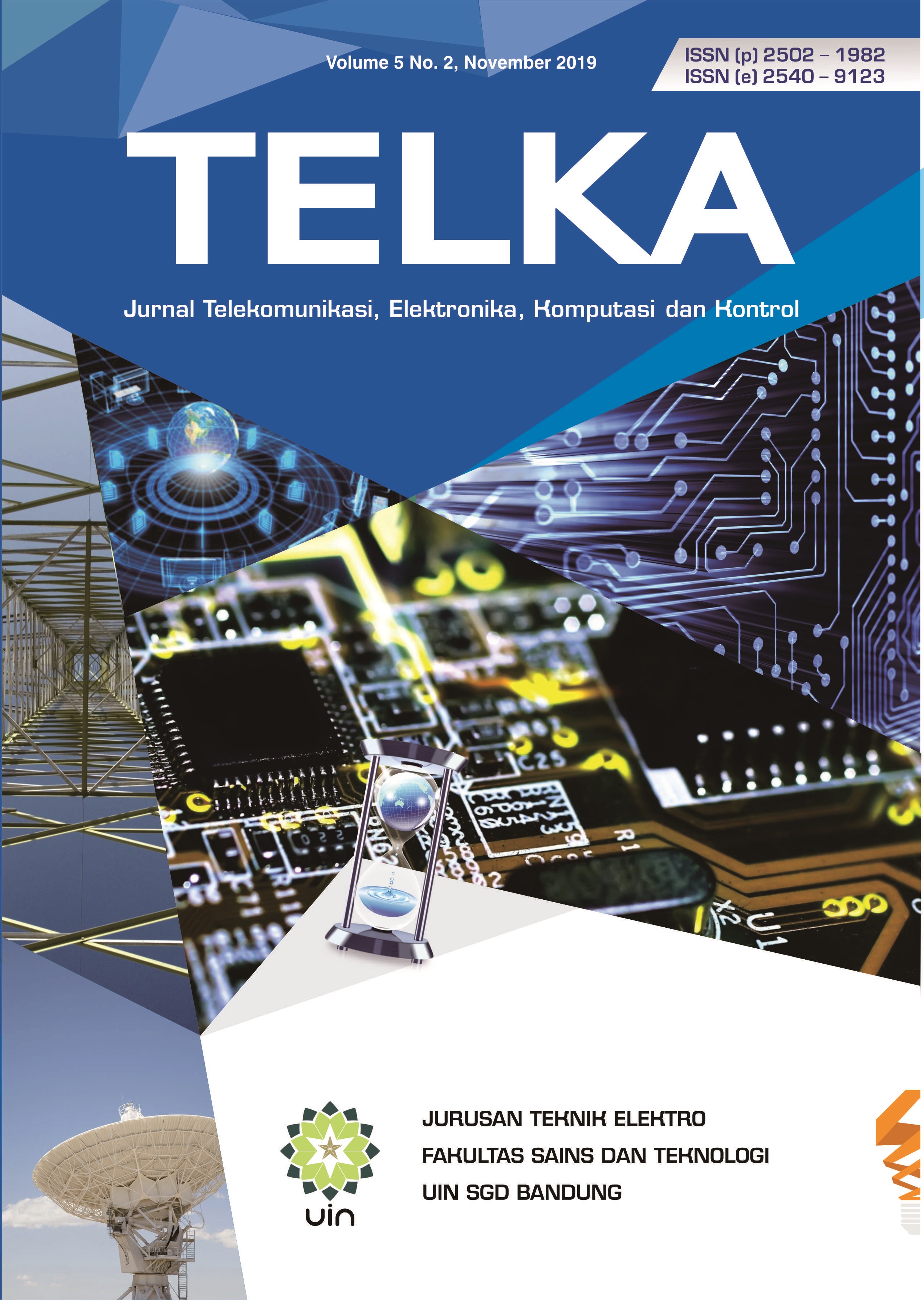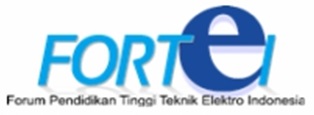Denoising Sinyal EEG dengan Algoritma Recursive Least Square dan Least Mean Square
DOI:
https://doi.org/10.15575/telka.v5n2.122-129Kata Kunci:
Electroencephalography, Recursive Least Square, Least Mean Square, Mean Square Error, Signal to Noise Ratio, Peak Signal to Noise RatioAbstrak
EEG mengukur fluktuasi tegangan yang dihasilkan dari arus ionik yang beredar sepanjang neuron otak. Dalam pengaturan eksperimental, sinyal EEG sering terkontaminasi dengan berbagai noise akibat gerakan otot dan jantung. Noise dengan magnitudo yang lebih tinggi dari sinyal aslinya akan merusak sinyal EEG dan bisa berakibat fatal dalam analisis diagnosa. Sehingga diperlukan sebuah sistem denoising yang mampu secara maksimal mengurangi noise, tanpa menghilangkan komponen informasi penting dari sinyal EEG. Salah satu algoritma yang dapat digunakan dalam mereduksi noise pada sinyal biomedis adalah RLS dan LMS. Keuntungan utama dari penggunaan adaptif filtering termasuk RLS dan LMS adalah dapat digunakan pada lingkungan non-stasioner. Tujuan penelitian adalah melakukan uji perbandingan performansi filtering RLS dan LMS dalam mereduksi noise pada sinyal EEG. Parameter performansi yang diukur adalah waktu komputasi, MSE, SNR, dan PSNR. Dari hasil pengujian, diperoleh bahwa adaptif filtering dengan RLS dan LMS mampu mereduksi noise pada sinyal EEG dengan baik. Filter LMS memiliki kelebihan pada waktu komputasinya yang singkat, rata-rata waktu komputasi filter LMS selama 0.7 detik, jauh berbeda dengan filter RLS yang membutuhkan waktu sampai dengan 113 detik. Tetapi kehandalan sistem dari sisi MSE, SNR dan PSNR untuk filter LMS masih berada dibawah RLS untuk intensitas noise yang rendah. Besarnya parameter SNR dan PSNR pada filter RLS cenderung lebih stabil pada intesitas noise 10 dB, 20 dB, dan 30 db. Hal berbeda terjadi pada denoising dengan menggunakan filter LMS, terjadi perubahan SNR yang signifikan dari 16.14 dB pada noise 10 dB, 21.09 dB untuk noise sebesar 20 dB, dan 25.81 dB untuk intensitas noise sebesar 30 dB.Referensi
S. Islam, A. M. El-hajj, H. Alawieh, Z. Dawy, N. Abbas, and J. El-imad, “Biomedical Signal Processing and Control EEG mobility artifact removal for ambulatory epileptic seizure prediction applications,” Biomed. Signal Process. Control, vol. 55, p. 101638, 2020.
N. Bajaj, J. Requena, F. Bellotti, R. Berta, and A. De Gloria, “Biomedical Signal Processing and Control Automatic and tunable algorithm for EEG artifact removal using wavelet decomposition with applications in predictive modeling during auditory tasks,” Biomed. Signal Process. Control, vol. 55, p. 101624, 2020.
C. J. Jeba and G. Suganthi, “Biomedical Signal Processing and Control An efficient denoising of impulse noise from MRI using adaptive switching modified decision based unsymmetric trimmed median filter,” Biomed. Signal Process. Control, vol. 55, p. 101657, 2020.
N. K. Muhsin, “Noise Removal of ECG Signal Using Recursive Least Square Algorithms,” Al-Khwarizmi Eng. J., vol. 7, no. 1, pp. 13–21, 2011.
X. Chen, X. Xu, A. Liu, M. J. McKeown, and Z. J. Wang, “The Use of Multivariate EMD and CCA for Denoising Muscle Artifacts from Few Channel EEG Recordings,” IEEE Trans. Intrumentation Meas., vol. 67, no. 2, pp. 359–370, 2018.
E. Estrada, H. Nazeran, G. Sierra, F. Ebrahimi, and S. K. Setarehdan, “Wavelet-based EEG Denoising for Automatic Sleep Stage Classification,” in 21st International Conference on Electrical Communications and Computers, 2011, pp. 295–298.
P. Gajbhiye, R. K. Tripathy, A. Bhattacharyya, and R. B. Pachori, “Novel Approaches for the Removal of Motion Artifact from EEG Recordings,” IEEE Sens. J., vol. 1748, pp. 1–10, 2019.
G. Kaushik, H. P. Sinha, and L. Dewan, “Biomedical Signals Analysis by DWT Signal Denoising With Neural Networks,” J. Theor. Appl. Inf. Technol., vol. 62, no. 1, pp. 184–198, 2014.
S. H. Sardouie, M. B. Shamsollahi, L. Albera, and I. Merlet, “Denoising of ictal EEG data using semi-blind source separation methods based on time-frequency priors,” IEEE J. Biomed. Heal. Informatics, vol. 2194, no. c, pp. 1–9, 2014.
K. Islam and A. Rastegarnia, “Probability Mapping Based Artifact Detection and Wavelet Denoising based Artifact Removal from Scalp EEG for BCI Applications,” in 2019 IEEE 4th International Conference on Computer and Communication Systems (ICCCS), 2019, pp. 243–247.
Harender and R. K. Sharma, “EEG Signal Denoising based on Wavelet Transform,” in International Conference on Electronics, Communication and Aerospace Technology ICECA 2017 EEG, 2017, pp. 758–761.
A. C. M. F. S. R. M. U. Ahmed, “A study of recursive least squares (RLS) adaptive filter algorithm in noise removal from ECG signals,” in 2015 International Conference on Informatics, Electronics & Vision (ICIEV), 2015, pp. 1–6.
V. Roy and S. Shukla, “Mth Order FIR Filtering for EEG denoising using Adaptive recursive Least Squares Squares Algorithm,” in 2015 International Conference on Computational Intelligence and Communication Networks, 2015, pp. 1–4.
J. Dhiman, S. Ahmad, and K. Gulia, “Comparison between Adaptive filter Algorithms ( LMS , NLMS and RLS ),” in International Journal of Science, Engineering and Technology Research (IJSETR), 2013, vol. 2, no. 5, pp. 1100–1103.
S.Arunkumar, P.Parthiban, and S. A. Kumar, “Implementation of Least Mean Square Algorithm For Sinusoidal and Audio Denoising Using FPGA,” Int. J. Adv. Res. Electr. Electron. Instrum. Eng., vol. 2, no. 12, pp. 5843–5850, 2013.
F. Ali, P. Rawat, and S. Malvia, “Comparative Analysis and Survey of LMS and RLS Adaptive Algorithms,” Int. J. Comput. Appl., vol. 161, no. 3, pp. 26–29, 2017.













